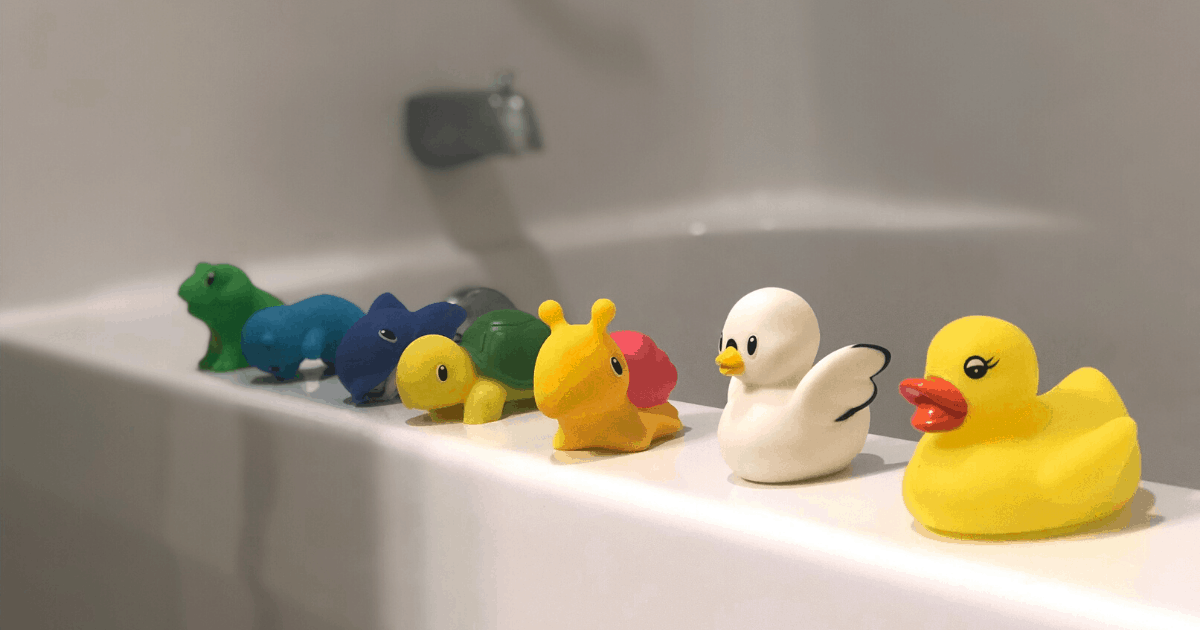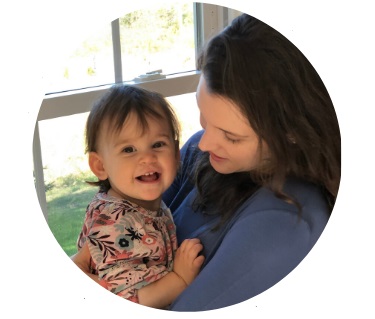
My toddler hated bath. She would scream and fight. In fact, she hated all types of water play. She was the kid who would cry when she got splashed or wet.
I didn’t know what to do and it seemed the more I forced bath time, the worse it got. Also, my bigger goal was not just to get bath time done but to teach her how much fun water could be.
It wasn’t until I learned about desensitizing and teaching positive associations that my world literally changed. I went from having a toddler afraid of bath who would run and hide at the mention of bath to one that wouldn’t get out of the bath and likes to put her face in the water.
So, if your toddler if suddenly afraid of bath, or has been afraid of bath since they were a baby, what can you do?
I had to start EXTREMELY small
The whole idea behind desensitizing is that you must come to their level first.
Let’s say someone is afraid of airplanes. A terrible idea is to throw them on a plane. Instead, you start small with maybe reading a book about planes or taking a trip to an airport and eventually you get on the plane. You increase exposure and every time the person successfully overcomes the fear in small amounts, they build confidence and a positive association.
If your toddler is terrified of a bath or water in general, then you need to be starting with drops of water. So how do you start with “drops of water”?
You find ways to get them in contact with (play with) water every day. Multiple times a day is better and try to make it fun (see next tip). Every time you do this you are building up to the bath. You are also building a positive association with water because every time child experiences water and realizes “it’s okay”, they are gaining confidence.
Find ways to add water fun EVERY DAY
An important part of increasing exposure to water is that it is fun. Since children learn through play, adding water play every day is key. Thankfully, there are many ways to do this:
- Splash in a puddle with rainboots
- Go out in the rain with an umbrella
- Sink play (get a chair or learning tower for them to stand on. Give them a bunch of plastic cups and let them “wash” the dishes).
- Get a small plastic bin of water and wash a baby doll, wash toys or float a boat
- Get some Scribble Scrubbie Pets for the older toddler
- Have a sprinkler on low so they can stick their feet in it
- Water the flowers with a watering can
- Buy or DIY a water table for outside
Really any way you can incorporate water into play is great. The goal is for them to get just a “little bit” wet and see how much fun it can be.
Check your reactions
During all of these fun experiences with water, you must check your reaction. They are going to model their reaction off of how you react to them.
First, be as excited and happy about water as you can be. When they get wet or their clothing gets wet and they lose their mind, do not get frustrated. Your frustration will be perceived by them as validating their feelings. They think wow this makes mommy really mad; it is a bad thing! I was right to fear it.
Instead, I clap my hands and say yay! If my toddler is screaming about her shirt being wet, then I say cool! I want my shirt to be wet. I then either splash or pour water on my shirt or I give her a cup of water and ask her to pour it on me. (I know, the things we do for our kids lol) Also, if their shirt is wet, then do not change it. Changing their shirt validates that a wet shirt is bad. Right now, we want to hammer home the point that water and being wet is great!
Just think about when a baby learns to walk. They try and your face lights up. Even when they fall and maybe cry, you don’t get frustrated that they are crying. Instead, you are so excited and say yay! You did it you took your first steps! The child is getting encouragement from you and that helps them to continue trying new things that might be intimidating or scary to them.
Let them be in control and reverse roles
If your reactions matter so much, then even better is for them to see you enjoying it. So, in addition to playing all of the water games I mentioned above, I also let my child dump cups of water on me.
“Wash the mommy” is my child’s favorite game. And it made a big difference for her. I will either get in the tub or if it is nice, I’ll let her dump water on me outside. The main point of this game is to let them be in control of the water. It is a role reversal. I fill a plastic bin with water and then I let her fill her cup and pour it on me. She watches my reactions intensely. The sillier and happier your reactions, the better.
You can even ask if you can take a turn and wash their hands or ask them what part of their body you can wash. If they say no, then respect that. You will get there, I promise.
Get a bath baby
Something that also really helped was getting them a baby doll to wash while in the tub. This gave them an activity and let them mimic bath time, but this time they were in control.
Try the tub again but with ALMOST NO water
After a week of incorporating water into our day and building up positive associations, we were finally ready to try the tub again. Now, the trick here is to do the same thing you did above, which was build from small to big.
So, the first time, you only want the tub to be filled a few inches with water. You can also fill the bathtub by filling a plastic bin and putting it in the tub. Close the drain and the tub will fill as your toddler dumps water out of the bin.
If they don’t want to take their clothing off, then let them wear clothing. You only goal here is that they get in the tub and have fun. As you progress, you can work on getting clothes off, etc.
If possible, try to bring their favorite water play or favorite toy into the bathtub. For instance, our toddler loves filling her cup and dumping it in water pipes. So, we had those along with a Minnie Mouse bath toy since she LOVES Minnie.
Repeat the bath each night but add a LITTLE MORE WATER each time
Now that your toddler has successfully gotten in the bathtub and had fun with water in the bath, you can work towards turning that water play in the tub into an actual bath. You do this by just increasing the amount of water in the bathtub each time until you have a full bathtub. Depending on your toddler, you could do this by filling the tub before they get in or by using the plastic bin method.
The plastic bin method is where you fill the bin with water and give your toddler a way to empty it such as dumping it everywhere with cups. They could dump their water on bathtub animals or in pipes etc. You can also help them dump the water into the bathtub with a second cup. When the water is all in the tub, then fill the plastic bin again until you reach the desire amount of water.
To not regress, make sure you do a bath every night until your child wants to take a bath. Honestly, this might sound like a lot of work, but I swear if you do this, your kid will quickly adjust to loving bathtubs.
Once, we started the bathtub using this method after a week of water play, it only took a week before I could fill the tub regularly and she would jump right on in. You just need to build a few experiences of positive association.
Remember during all of this to keep your reactions happy no matter what their reaction is (I know this can be hard sometimes). You will inevitably have a few times where they slide into more water or get splashed and they freak out again. As long as you make it positive with your reactions, you will keep progressing.
Try a COLDER bath
I am completely shocked at how “cold” my toddler likes her bath. What I thought was lukewarm is too hot for her liking. I also think this was part of the reason she didn’t like bath time. In fact, she likes it to be more pool temperature than bath temperature. I would especially start to play around with a different temperature tub especially if they like water play but don’t like baths.
How to conquer hair washing
We can take the same process and apply it to hair washing. You start by “washing” their body. They need to get use to the idea of water being poured on them. Start small by asking if they will wash your hands and then ask what part of their body you can wash.
You are desensitizing them to the feeling of water being poured on them.
You can also just be dumping water into the bathtub with your cup. You are playing and oops some water got on your toddler. And my toddler would get mad and I would say I was just playing silly mommy. I would always keep a smile on my face.
Once you have exposed them to that a lot, your next step is to just get them used to pouring water on their head. The last step is for them to be okay with water poured on their head. I think this is best accomplished if they do it themselves. I taught my toddler to scoop water into her hands and pour it on her head. We talk about how silly and fun it is for water to roll down your face. I have even stuck my head over the bath so she can do it to me, or I pour water on my head.
Something that really helped us was to teach our toddler to look up. We put wall decals on the ceiling and said look up at the princesses, which really helped. It also gave them something to look at to distract them and keep them looking up long enough for me to rinse their hair. It also allows me to dump a lot more water at a faster rate because it doesn’t go in their eyes.
Avoid goggles
There is an age where goggles are a good idea, but not when your child is learning how to swim. Goggles validate this fear kids have about water in their eyes. Kids need to learn to close their eyes and see that water on their eyes is okay. Goggles are a crutch and should only be used after your kid knows how to swim without them.
I also feel it is so important to teach kids to swim without any crutch for safety reasons. I need to know if my kid fell into the water, they could swim without goggles. I was the kid who was afraid of water in my eyes and so if my eyes got wet, I wouldn’t open them. I was a horrible swimmer without goggles.
Pursue Bath time Today
I promise this too shall pass and you will soon have a little fish on your hands. I know how tough it can be to overcome a fear since toddlers are able to throw the best temper tantrums in the world. I hope by writing this guide I can help you and your little find ways to make water and bath time more fun and enjoyable. Just remember to go from small to big water play, frequently is key and stay positive in your reactions.
If you have any tips that helped your toddler not be afraid of bath, then please share in the comments.
If you found this post on toddler afraid of bath helpful, please share it on Pinterest or Facebook


I am a wife, teacher, and mother to two awesome girls. I write about what I am passionate about, which includes being a mom, house projects, beauty and skincare. I love to share my experiences, failures, and successes with my readers. Let this space be a resource for you to pursue your very best day.



